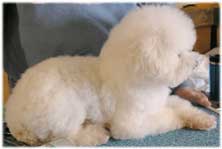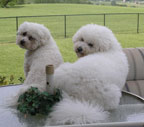|
||||||||||
|
SOCIALIZATION OF |
||||||||||
BASIS: Whether by isolated living, poor handling or genetics, shy dogs need to receive behavioral modification in order for them to be socially adept. |
||||||||||
ROUTINE SITUATIONS: Rescues often get dogs of all ages turned in with some degree of shyness. Some of these are young dogs who were purchased as 'cute' puppies by private individuals but the pups never received proper socialization, positive handling & manners training. Some are adult dogs raised by shy people. These dogs have never been exposed to people and situations and therefore have no skills to handle them. Some are dogs who have been living in cages with limited human contact and used for breeding before being surrendered into rescue when their breeding capacity was no longer profitable, or the producer suspended business. |
||||||||||
NEEDS: Whether the dog was allowed to remain unsocialized within a private home, or received rough handling which has left it distrustful, or has been a neglected breeder dog, all share the great need for human understanding and careful handling. It is going to require time and patience in order for the dog to learn to trust. Some dogs will respond rather quickly, other can take many months or even years .. others never come around . Some, particularly those whose shyness is genetically based, may never become fully confident and trusting. Some may become confident around family members, but remain aloof & distrusting of strangers. |
||||||||||
TIMING: Allow the dog to progress through socialization lessons at his/her own pace. If it is very shy of you, allow the dog to approach you when s/he is comfortable doing so. |
||||||||||
| DEVELOPMENT: A shy adult dog needs to be considered to be at the mental development of around a 6-week old puppy and should be treated similarly. (Step by Step Puppy Socialization) Much will be new and scary to this dog. S/he may have never experienced the normal household sights and sounds that we (and most dogs) take for granted. The whole transition to a social environment may be very traumatic and overwhelming. The dog will likely need some quiet time to settle down and process all the new things that s/he is being exposed to. Provide the dog with a den (preferably a crate) where he can "hide" and safely observe the household routine. Use 'time out' in a pen/crate regularly. Close the door for short periods to allow him to relax and de-stress. When s/he is spending these short time outs in the crate, ignore the dog. Although it is tempting to keep the dog with you and cuddle it all the time, be sure to give the dog his/her space and do not crowd it with your need to pamper. . It is very unsettling and stressful for these guys to go from a "nobody" to suddenly being the center of attention. |
||||||||||
Always move slowly and speak softy around the dog. Pick him up gently - many dogs resort to "fear biting" when startled or scared. Keep children away as much as possible. See if the dog will accept food or treats from you - this is a good "first step" toward gaining his confidence. If he will not accept them, that is okay. Wait a few days and then try again. |
||||||||||
| Introduce new sights, sounds, people, and other pets slowly. Having never heard a vacuum cleaner, door bell, telephone, etc., these things can be terrifying to the dog. THINK before turning on that food processor...it would be a good idea to put the dog in another room first. Give him time and permission to explore his surroundings. It is not necessary to immediately correct him when he investigates things that will be future forbidden things...let him look them over. Chances are he will not bother them....he just has never seen anything like that shoe (or magazine, or vase, or whatever) before. But be prepared to immediately stop him if he DOES start to bother anything. (yes, we warned you this was going to take time and tenacity.) | ||||||||||
| Enroll in an obedience
class. Manners are wonderful, but more importantly when dealing with
shy dogs is the ability to create confidence through obedience exercises. |
||||||||||
FEEDING Feed the shy dog separately from your own dogs for the time being. Many puppymill dogs have had to compete for food and can be either food aggressive or so submissive they'll allow other dogs to take the lion's share of the food. While this is a problem that needs to be addressed, don't add to his stress at this time by making a big issue of it. Simply feed him by himself for a while - you can work on this AFTER he's more comfortable. [Another note here - you may have to feed him off the floor for a while. Some of these guys have never been taught to eat out of a bowl and it scares them to put their head down into a bowl. If this happens to be the case, let him eat his food directly off the floor - it wonšt hurt him. To gradually introduce him to the bowl, start by offering him food out of your hand. Once he'll comfortably take food out of your hand, start placing a small amount of food (or a treat) in the bowl and holding the bowl while offering it to him. He'll eventually overcome his fear of the bowl and you'll no longer have to hold it. But donš't rush him...he'll come around. |
||||||||||
HOUSETRAINING Patience, patience, patience !!!!! Remember, mill dogs have been kept in a cage all of his life so all he knows is to piddle or poop whenever the urge hits him. He's never been trained to "hold" it and has NO concept of this idea. It can easily take MONTHS to see any headway in this area. Take the dog out frequently (or to his papers), praising him whenever he goes. Always take him out upon awakening and after eating. Keep a very close eye on him when he's loose in the house - the more accidents he has in the house without correction, the harder it will be to get the idea across. DO NOT rub his nose in it or scold him! When you catch him in the act (I repeat - when you catch him in the act!), tell him "NO" and immediately pick him up and take him to his appropriate place (either outside or his papers). Crate the dog whenever gone or busy - dogs naturally do not like to soil their sleeping area. While he'll probably mess his crate up at first (again, that's all hešs ever known), once he figures out that he doesn't HAVE to, he'll start to get the idea. Again - PATIENCE and PRAISE. A treat might also be in order when he goes out as requested. Accidents WILL happen - simply take him outside (or to his papers) and tell him to "Go Potty". Donšt make a big deal of an accident - but DO make a big deal of it if he goes out as requested and does his business. Leaving a small piece of urine-soiled paper on top of his piddle papers/pads will also help him identify "his" spot to go. Likewise, clean all other accident sites with a neutralizing cleaner to remove all traces of his scent. Belly bands are good for little boys - they won't stop the accidents, but will help protect your furniture and carpets. Belly bands are not to be used in place of constant observation and are not a training aid - they won't "teach" the dog anything. This is another area where existing dogs can be beneficial in helping train the newcomer. As he goes out with them and sees them doing their business, it will help him understand what it is you're asking of him...sort of a "monkey see - monkey pee" type situation. If you put him outside, it's also a good idea to put him in an X-pen at first...a scared dog is hard to catch in even a small backyard. |
||||||||||
NAME A name is important in establishing communications with the dog. It also helps him to feel like a valued member of the family. Select something that both of you are comfortable with. |
||||||||||
|
|
||||||||||
|
While there's a lot of work involved in rehabilitating a
shy dog, the work
is not nearly as great as the rewards. Your dog will slowly come out of his
shell a little more each day and you'll see him begin to develop into a
beautiful creature with endless love.
Be patient, be persistent, and be calm... |
||||||||||

